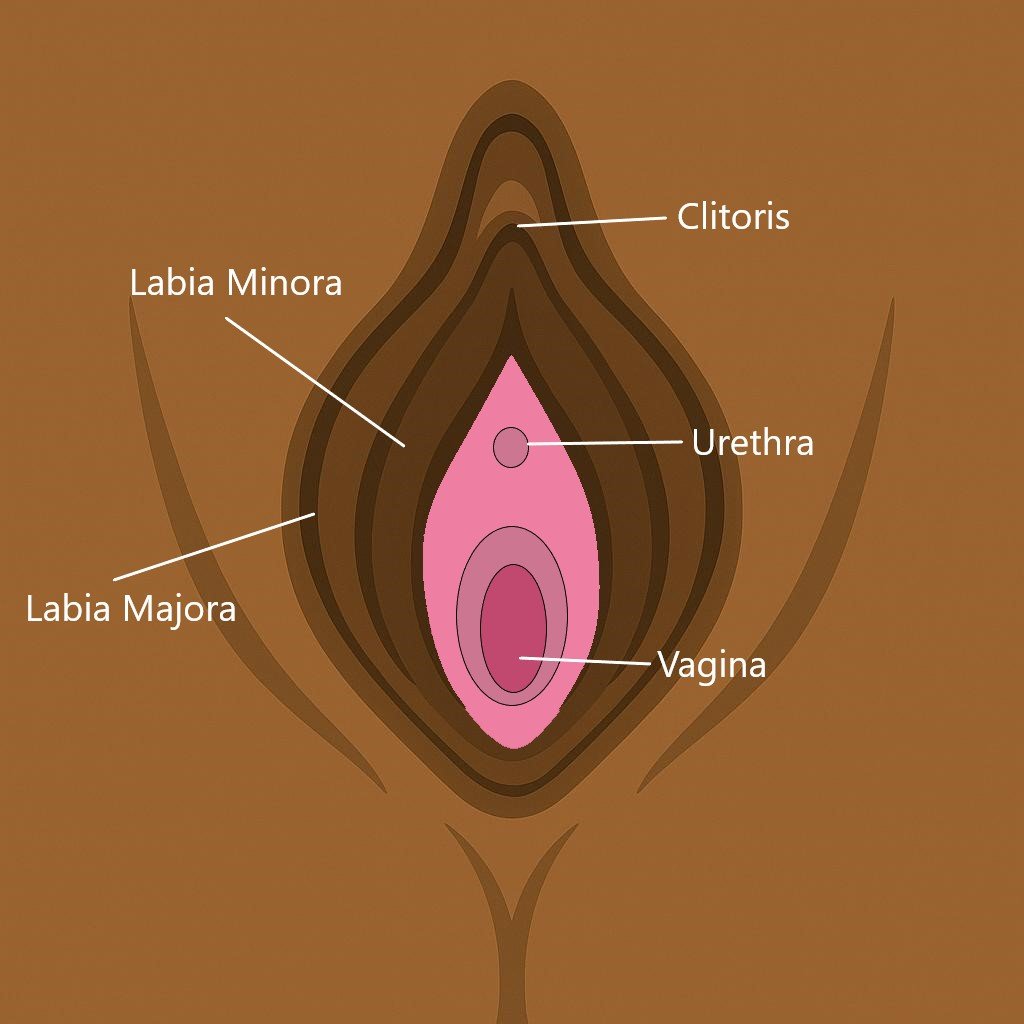This is The Manual
For the things you were too embarrassed to ask the group chat, too tired to explain to another doctor, or too scared to have Google tell you you’re dying.
We will continue to upload articles on new topics to keep the wisdom flowing.
Heads Up: This info is here to educate, not diagnose. Talk to a real-life doctor for medical advice - and read our medical disclaimer before diving in!
Hysterectomy: What It Really Means to “Take Out the Uterus”
Few words in gynecology carry as much weight as hysterectomy. Whether it’s said casually (“they just took everything out”) or whispered in fear, it tends to make people pause. But a hysterectomy isn’t one single procedure—it’s a spectrum of options that look a little different for everyone. Here’s what it really means, what’s actually removed, and what to expect along the way.

Bartholin’s Cyst: When the Plumbing’s Backed Up
You’re minding your business one day and notice a lump near your vaginal opening. Cue instant panic. Before your brain jumps to the worst-case scenario, take a breath. You might have what’s called a Bartholin’s cyst—a common and completely treatable reason for a lump “down there.”

Fibroids: What They Are and What to Do About Them
The uterus is a remarkable organ. It’s built to go from the size of a tennis ball to the size of a basketball in just nine months, growing and housing an entirely new human being along the way. That’s miraculous. No other organ in the body can expand, contract, and regenerate quite like it.
But with that much power comes a lot of responsibility, and a few design flaws. Complex systems are prone to glitches, and fibroids are one of them. Think of them as a glitch in the uterine code: a spot where the muscle tissue gets a little too enthusiastic and starts multiplying in one area, forming a firm, rubbery ball inside or on the uterus. They’re extremely common, usually benign (non-cancerous), and vary widely in size and effect. Let’s break down what they are, why they show up, and what to do about them.

Endometrial Biopsy: Why It’s Done and What to Expect
If you’ve just been told you need an endometrial biopsy, you might be feeling a mix of confusion, anxiety, and curiosity. That’s completely normal. This procedure can sound intimidating, and for some people it’s genuinely uncomfortable. Understanding what’s happening, why it’s being done, and what to expect can help you feel a little more in control when it’s time for your appointment.

Vaginal Atrophy: The Dry Truth
Let’s talk dryness down there. Vaginal atrophy, or genitourinary syndrome of menopause (GSM), happens when declining estrogen levels lead to changes in the vaginal and urinary tissues. Think of estrogen like nutrients for those tissues—when levels drop, it’s like a garden not getting watered. The skin might even become thinner, less elastic, and less able to produce natural moisture. This can make the skin itchy, irritated, and dry, making things like sex, pelvic exams, or even sitting too long uncomfortable. The pH level shifts too, allowing fewer “good” bacteria (like lactobacilli) and more irritation-causing microbes to move in, sometimes leading to infections or recurrent BV-like symptoms.

Herpes Happens: What to Know and How to Deal
If you’ve just been told you have herpes, take a breath. You’re not broken or gross, and you’re definitely not alone. Herpes is one of the most common infections on the planet, and most people who have it don’t even realize it. It’s a virus, not a verdict, and the more we talk about it, the less scary it gets.

Yeast Infection: What It Is, Why It Happens, and How to Kick It
Yeast infections are incredibly common. And while the name might sound like something you'd expect to be gross or shameful, the truth is they’re just a very normal overgrowth of a fungus that lives in and on your body. They're manageable, treatable, and most importantly — not your fault.

Adenomyosis: The Angry Uterus
Ever feel like your uterus is trying to kill you every month?
Like the cramps are intense, the bloating is relentless, and the bleeding looks like a crime scene?
This could be adenomyosis - the angry uterus. It’s surprisingly common, but way less talked about than conditions like endometriosis or fibroids. If you're dealing with pain and bleeding and no one has given you a name for it, this might be it.

Pelvic Floor Physical Therapy: Your Guide to a Stronger, Happier Pelvis
Whether you’re leaking when you laugh, feeling pressure where you shouldn’t, or struggling with pain no one seems to understand, pelvic floor therapy offers a path toward healing that too many people still don’t know exists.

UTI Survival Guide: Your Burning Questions Answered
This guide covers what a UTI actually is, how to treat one, what not to do, and how to (hopefully) prevent it from happening again.

Tracking Ovulation: How to Know When That Egg’s Dropping
So, you want to figure out when your ovary is ovulating. Whether you're trying to get pregnant, avoid it, or just want to know what your hormones are up to, tracking ovulation is one of the most powerful things you can do for your health.
But let’s be real — it can feel like trying to crack a secret code written in discharge and mood swings. Here’s how to make sense of it all.

LEEP: What Is It, and Why Do I Need One?
So what exactly is a LEEP? And why might you need one?
If your doctor mentioned a LEEP after your Pap smear or colposcopy, you're not alone — and you're not in danger. A LEEP is a simple outpatient procedure that removes abnormal cervical cells before they turn into cancer. That’s right: this little procedure is done to prevent cancer, not treat it.

Colposcopy: What to Expect and How to Prepare
So you’ve been told you need a colposcopy. Now what?
We get it — hearing that can feel overwhelming. You might be panicking, Googling, or just quietly freaking out. But here’s the thing: colposcopies are incredibly common, and you’re not alone. Even though it might feel like you’re suffering in silence, thousands of people have this exact procedure every day — and we’re here to walk you through it, demystify the experience, and help you feel more in control.

Crossing the Finish Line: A Guide to Getting There (Together)
He came. You cuddled. The end?
If that sounds familiar, you’re not alone. There’s a well-documented “orgasm gap” between cisgender men and women during partnered sex — meaning people with penises tend tofinish far more often than those with vulvas. That’s not because one body is better designed for pleasure — it’s because the game is often rigged.

Pap Smears: Don’t Brush It Off
Let’s talk about that appointment you keep rescheduling. You know the one — awkward, uncomfortable, and battling the dentist for your least favorite appointment. The Pap smear may not be anyone’s idea of a good time, but it’s one of the simplest ways to protect your health. And once you know what it’s actually doing (and what to expect), it gets a whole lot less scary. Let’s break it down.

HPV: Everyone’s Got It, No One Talks About It
HPV is the most common sexually transmitted infection in the world — and somehow still the one we talk about the least. It’s not dramatic like herpes, curable like chlamydia, or rare enough to feel exotic. It’s just… there. Quietly passed from partner to partner, often without anyone realizing.

Down There, Up Close: A Guide to the Bits Below
So, you’ve got a vulva. Or you’re just vulva-curious. Either way, welcome to the tour. No shame, no weird old textbook diagrams, no confusing terms like “vestibule” without an explanation. Just a little anatomy 101 for the parts most of us weren’t properly introduced to — even though we live with them every single day.

The Menstrual Cycle: Your Monthly Programming
We’re taught from the start that a “normal” menstrual cycle is 28 days. But that’s like saying every person should be 5'6" with brown eyes and a love for iced coffee. It’s a baseline, not a blueprint—and your body has its own version of normal.

Hormone Replacement Therapy: I’ll Have What She’s Having
You know the type. She’s 52, glowing, sleeping through the night, and not melting into a puddle during meetings. And while you're debating whether to buy another fan for your desk or just give up entirely, you find yourself wondering: What is she having? And more importantly — can I get it too?

Pelvic Exams: Let’s Get This Over With
No one’s ever said, “You know what I’m excited for? Getting a speculum inserted by a stranger.” And honestly? Fair. Pelvic exams can be awkward, uncomfortable, or just deeply not on your to-do list — especially if it’s your first time or you’ve had a bad one before. But here’s the truth: it doesn’t have to be awful. With the right provider, a little prep, and a few good tricks, it can be quick, manageable, and actually empowering. Let’s break down what’s happening, what’s normal, and how to make it way less sucky.
Sign Up for our Newsletter so you don’t miss out when new articles drop!
Can’t find an article about a topic you’re curious about?
Join the Femanual Community!
Join our email list and become part of the Femanual community — people who are getting to know their bodies, and learning to love them.
We’ll send you a heads-up when new articles drop or questions get answered, so you can stay informed, stay curious, and stay connected.


